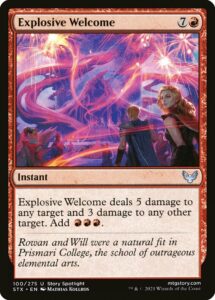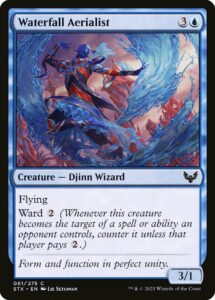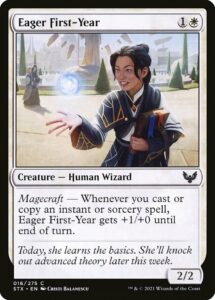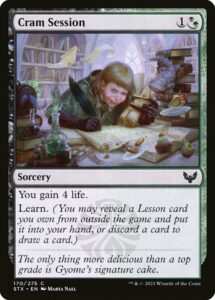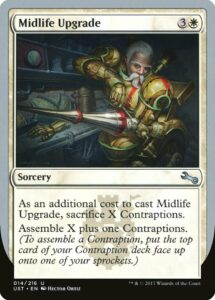As we wait the couple more days for Kamigawa: Neon Dynasty spoiler season to begin, let’s look back at one of the better parts of 2021—the Magic. As with every year, there were many new mechanics added to Magic’s roster, and last year had some of my favorites of the past decade.
This will be part four of our five part series covering all the new mechanics (in Standard expansions) of the last year. We’ve covered Innistrad: Midnight Hunt, Adventures in the Forgotten Realms, and Innistrad: Crimson Vow. Today, we return to spring of 2021 and the introduction of Magic’s Academy World, Arcavios, the home of Strixhaven.
A new take on a faction set
Strixhaven presents an alternative approach to Ravnica. Its five enemy colored colleges are mechanically and thematically distinct from their Ravnican versions. Unlike Ravnica, each faction shares all major mechanics with every other faction. Sure, they all have their own distinct play patterns and subthemes, but share far more unifying structure than any two Ravnican guilds do. Strixhaven is the first set built around instants and sorceries—a hefty challenge given how essential creatures are to Limited. All of this is accomplished through Strixhaven’s four new mechanics: Learn, Lessons, Magecraft, and Ward (which was immediately promoted to an evergreen keyword).
Not as good as Hexproof, and that’s a good thing
Ward has been part of Magic for a long time, but as a sparingly used keyword on cards like Frost Titan, Diffusion Sliver, and Unsettled Mariner. It simply wasn’t necessary to be keyworded when Magic had mechanics like Shroud, Hexproof, and Protection. Well, as time went on, Shroud was retired (more confusing than Hexproof with less interesting play patterns) and Protection was brought in and out of retirement (a very confusing mechanic). Hexproof is a desirable mechanic, but a dangerous one to employ in volume or on cheap creatures. This left an opening for a new defensive mechanic, one weaker than Hexproof and both less powerful and less confusing than Protection.
Ward is a clean solution to a long-running problem. It’s not a perfectly clean mechanic, since it fizzles a removal spell if an opponent isn’t paying close attention. I was initially surprised that it didn’t present an additional cost like Boreal Elemental, but that would both complicate having different costs like discarding cards and paying life and be especially wonky with triggered abilities.
Once I got past that tiny bit of awkwardness, I was fully aboard the Ward train. It does its job well. It’s meaningful even at small numbers on cards like Plate Armor. It has a built-in safety value where Wizards can simply print uncounterable cards like Heated Debate rather than making Hexproof-specific counters like Detection Tower. And it just works—it allows for slightly stickier cheap and midrange creatures without entirely invalidating removal. There’s a benefit to still having some creatures with Hexproof, but the introduction of a less powerful defensive mechanic that is designed to work differently in different colors, well that’s a great success in my book.
A second successful callback
Back in 2014, Prowess was poised to become the new blue-red evergreen keyword. It would not hold that position for long. Prowess is awkward as the evergreen creature keyword reliant on a triggered ability. It also requires a reasonable amount of support. Its inclusion can muddle the message when an archetype is about artifacts (Dominaria), enchantments (Theros Beyond Death), or instants and sorceries (Guilds of Ravnica). It always having the same output of a temporary +1/+1 could be overly restrictive and would make similar cards (like Sage of the Inward Eye in Khans of Tarkir) read differently. These issues would lead to Prowess’ diminished use and eventual sunsetting as an evergreen keyword. It’s still used from time to time, but it no longer bars the way for a similar mechanic.
Magecraft presents an alternate path. As with Prowess, it has a unified input (casting instants and sorceries), but it being an ability word allows it to have varied outputs. This allows for different styles of Magecraft decks. Silverquill aggro plays more like Prowess, where you convert spells into bonus damage, while Witherbloom’s Magecraft can play more like Extort where you slowly bleed your opponent out with life gain and drain. I love this versatility.
We’re unlikely to see Magecraft again outside of a return to Strixhaven or a one-off card in Modern Horizons 3. You simply need a lot of a support to make instants-and-sorceries-matter a big enough theme to justify a named mechanic. But it makes me excited for the next mechanic like Constellation or Historic, where Magic finds a new way to create a world-specific mechanic with unified inputs and varied outputs. Perhaps one day there will be a world where the opposite somehow makes sense.
Two in one is a two for one
It’s impossible to talk about Lessons without talking about Learn, and vice versa. Learn is far stronger when it’s grabbing a Lesson rather than rummaging, and Lessons are far stronger when you’re grabbing them from your sideboard instead of drawing them from your deck.
I love this pair of mechanics. Seriously, it’s among my favorite mechanics of all time. It make later draft picks more meaningful. It allows you to fill your deck with more spells than actually fit, providing the essential structure for Magecraft to function. It makes the sideboard meaningful in best of one and allows for game one sideboarding in best of three. It lets you craft a custom spell chain, and does so without the repetitive play patterns of Splice onto Arcane.
The mechanical work is also spot on. Because Learn functions even when you run out of (relevant) Lessons, the mechanic works even when it’s not at its best. It’s more forgiving than Madness or Splice, mechanics which do nothing when you lack support. Lessons being overcosted makes total sense when you consider they’re free draws. You also recoup a little bit of this lost mana when you consider that Learn adds 1 mana to a card’s cost while drawing a card adds 2 mana.
In isolation, it’s very odd that Lessons are tutored for rather than drawn randomly from a Lesson Deck, except Unstable’s Contraptions already demonstrated the issue with that implementation. It’s stronger to just play one awesome Contraption you’re guaranteed to Assemble and ignore the mechanic afterward, than it is to have a pile of Contraptions diluting the quality of your Contraption deck. Lessons let you pick and choose so you’re rewarding for playing more of them! I love that Unstable was the crucible that helped Lessons emerge in this highly polished form.
Not every Lesson is a hit—Teachings of the Archaics may be a Standard player, but it’s also a confusing read that sometimes does literally nothing. It’s not clear how much design space there is left for Lessons, given that we’ve already seen many staple effects and Lessons have to be overcosted. Lessons and Learn demand massive structural support in order to function. They can lead to convergent play patterns, where everyone at the table drafts them highly and plays the same cards. And despite my adulation, the mechanic pair doesn’t seem to have been widely adored.
It would likely take a return to Strixhaven to see them return, and given how much they demand of a set, I wouldn’t be surprised that such a return would eschew Lessons to play in a different design vein. But nevertheless, I have exceptionally fond memories of Learning Lessons and would love to do so again.
Strixhaven is a fascinating confluence of design. I find its mechanics phenomenal. Magecraft and Lessons/Learn are perfectly intertwined to allow each other to thrive. Ward is a great workhorse mechanic that addresses longstanding issues with protection. I admire Strixhaven’s attempt to distinguish its colleges from Ravnica’s guilds, even though Quandrix felt fairly Simic and the innovative Lorehold barely functioned in Limited. I have deeply fond memories of the mechanics and the Mystical Archive, but my memories of the Limited format are mixed—the decks were sweet to play, but weren’t especially varied. I outright disliked the set’s use of modal double faced cards, especially its legendary Deans. They managed to be covered in far too much text, yet somehow many still had nonfunctional sides.
All in all, Strixhaven is a set with exceptionally high highs marred by several issues of different stripes. Its mechanics aren’t perfect, but in both isolation and unison, I must applaud them. And perhaps there’s a good lesson for us all in that—while there were a bunch of things I didn’t love in Strixhaven and a few that I quite disliked, there were elements that I loved. That’s more than enough to be happy.
Zachary Barash is a New York City-based game designer and the commissioner of Team Draft League. He designs for Kingdom Death: Monster, has a Game Design MFA from the NYU Game Center, and does freelance game design. When the stars align, he streams Magic (but the stars align way less often than he’d like).

